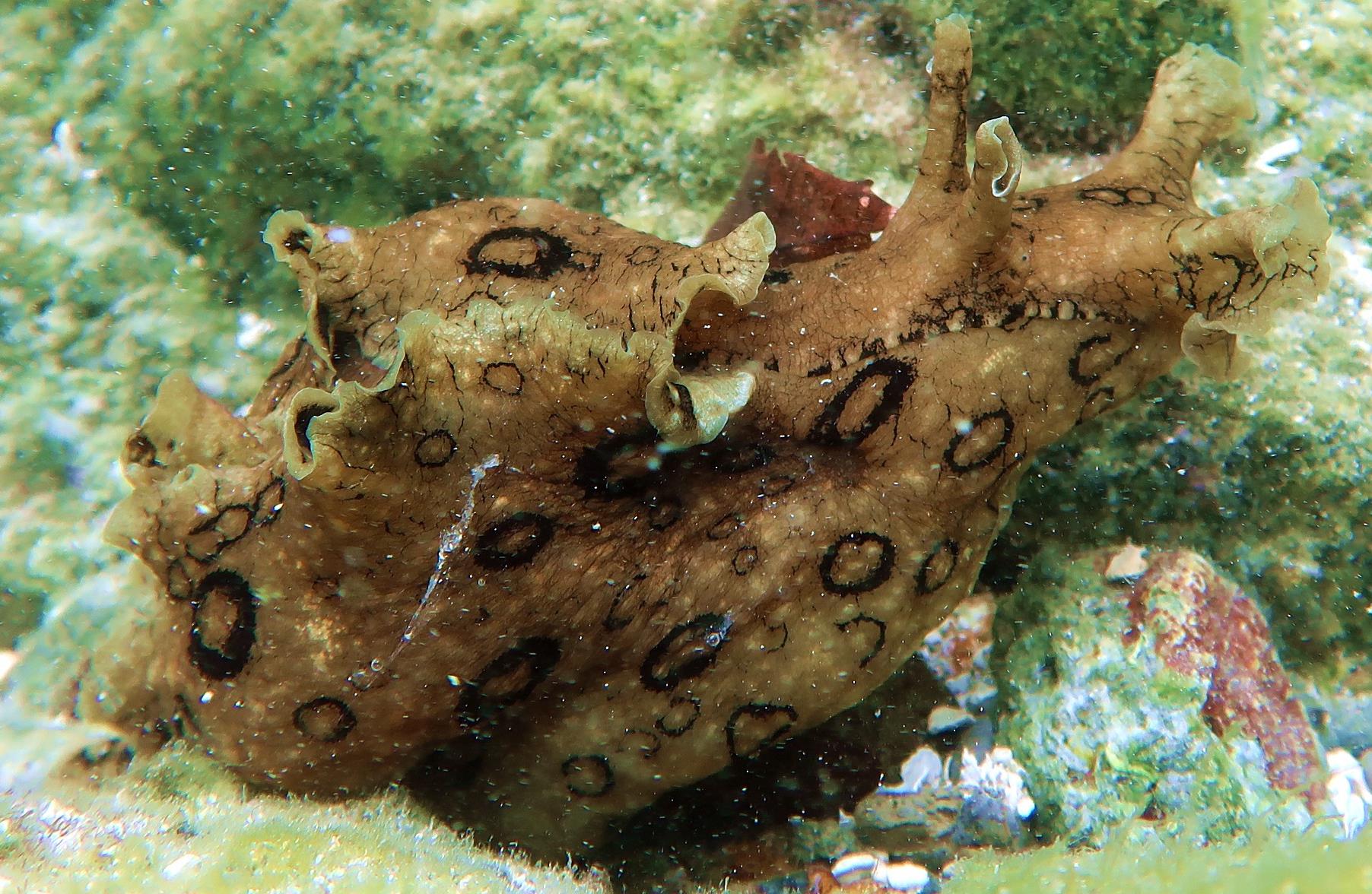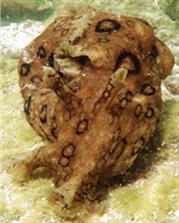



Aplysia dactylomela
Size
To 20cm
Description:
Yellowish tan, green to dark with black-ringed spots. Ruffled parapodia usually remain closed over back.
Ecology
Feeds on red, green and brown aldae plus sea grasses.
Will discharge a cloud of harmless purple ink when threatened, which is an irritant that causing altered behaviour in other invertebrates and fish. There are 2 main secretory glands in the mantle cavity: the purple gland on the top of the mantle cavity above the gill (purple ink) and the opaline gland on the floor of the mantle cavity (white opaque secretion).
The body and ink pigments are extracted from their algal food. Their leathery skin contains toxins, also from algae, which makes it practically inedible to most predators
Found in shallow waters, tide pools and rocky and sandy substrates, they also will be found feeding in beds of sea grass. During the day they will mostly hide under large rocks and in crevices. They are also found feeding in beds of sea grass.
It is capable of swimming and crawling. It accomplishes the former by creating a funnel using the parapodia folded forward and downwards; this action pulls in water. It then pushes the water out from behind the animal by pressing the anterior parts of the parapodia together, thus forward motion is achieved. The usual mode of propulsion is crawling, lifting the front end of the foot, stretching it forward then placing it on the ground in front, creating an arching pattern; the remainder of the body follows this arching pattern until the tail is reached
Life Cycle
Simultanious hermaphrodites. The penis is on the right side of the head while the vagina is situated in the mantle cavity, beneath the shell, deep down between the parapodia. It is therefore physically impossible for mating partners to act as both male and female at the same time.
They have unusual mating habits: they can mate in pairs with one acting as a male, the other as a female, but they commonly occur in quite crowded numbers during the mating season, and this often leads to chains of three to ~20 sea hares mating together. The one at the front acts as a female and the one at the back as a male. The animal(s) in between are acting as both males and females, i.e. the animal receiving sperm passes its own sperm to the next sea hare.
To 20cm
Description:
Yellowish tan, green to dark with black-ringed spots. Ruffled parapodia usually remain closed over back.
Ecology
Feeds on red, green and brown aldae plus sea grasses.
Will discharge a cloud of harmless purple ink when threatened, which is an irritant that causing altered behaviour in other invertebrates and fish. There are 2 main secretory glands in the mantle cavity: the purple gland on the top of the mantle cavity above the gill (purple ink) and the opaline gland on the floor of the mantle cavity (white opaque secretion).
The body and ink pigments are extracted from their algal food. Their leathery skin contains toxins, also from algae, which makes it practically inedible to most predators
Found in shallow waters, tide pools and rocky and sandy substrates, they also will be found feeding in beds of sea grass. During the day they will mostly hide under large rocks and in crevices. They are also found feeding in beds of sea grass.
It is capable of swimming and crawling. It accomplishes the former by creating a funnel using the parapodia folded forward and downwards; this action pulls in water. It then pushes the water out from behind the animal by pressing the anterior parts of the parapodia together, thus forward motion is achieved. The usual mode of propulsion is crawling, lifting the front end of the foot, stretching it forward then placing it on the ground in front, creating an arching pattern; the remainder of the body follows this arching pattern until the tail is reached
Life Cycle
Simultanious hermaphrodites. The penis is on the right side of the head while the vagina is situated in the mantle cavity, beneath the shell, deep down between the parapodia. It is therefore physically impossible for mating partners to act as both male and female at the same time.
They have unusual mating habits: they can mate in pairs with one acting as a male, the other as a female, but they commonly occur in quite crowded numbers during the mating season, and this often leads to chains of three to ~20 sea hares mating together. The one at the front acts as a female and the one at the back as a male. The animal(s) in between are acting as both males and females, i.e. the animal receiving sperm passes its own sperm to the next sea hare.

| Ecological Descriptors | ||||
| Habitat | Size (cm) | Diet | Behaviour | Sex |
| R, S | 20 | Veg | I | SH |

Spotted Seahare



Spotted Seahare
Spotted Seahare
588
441
589



